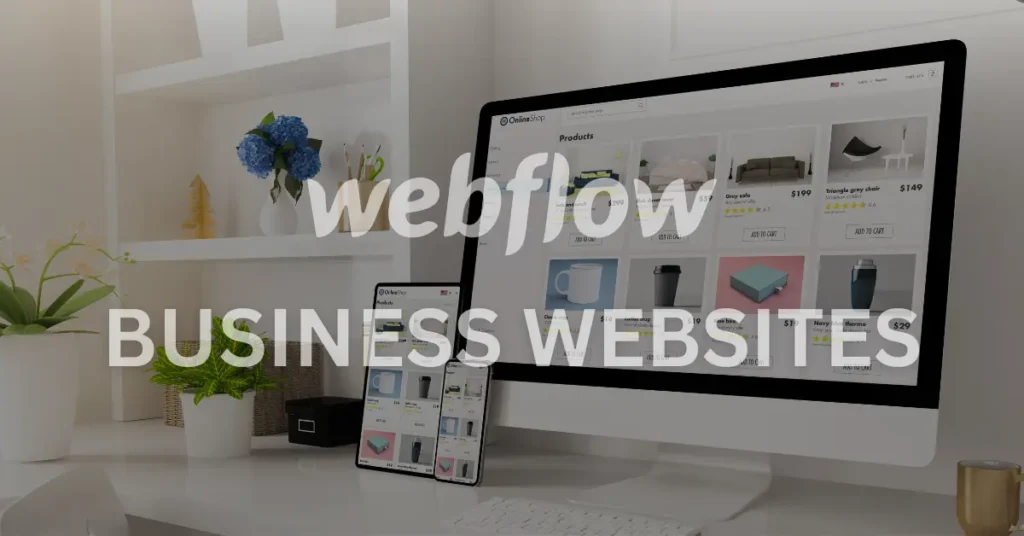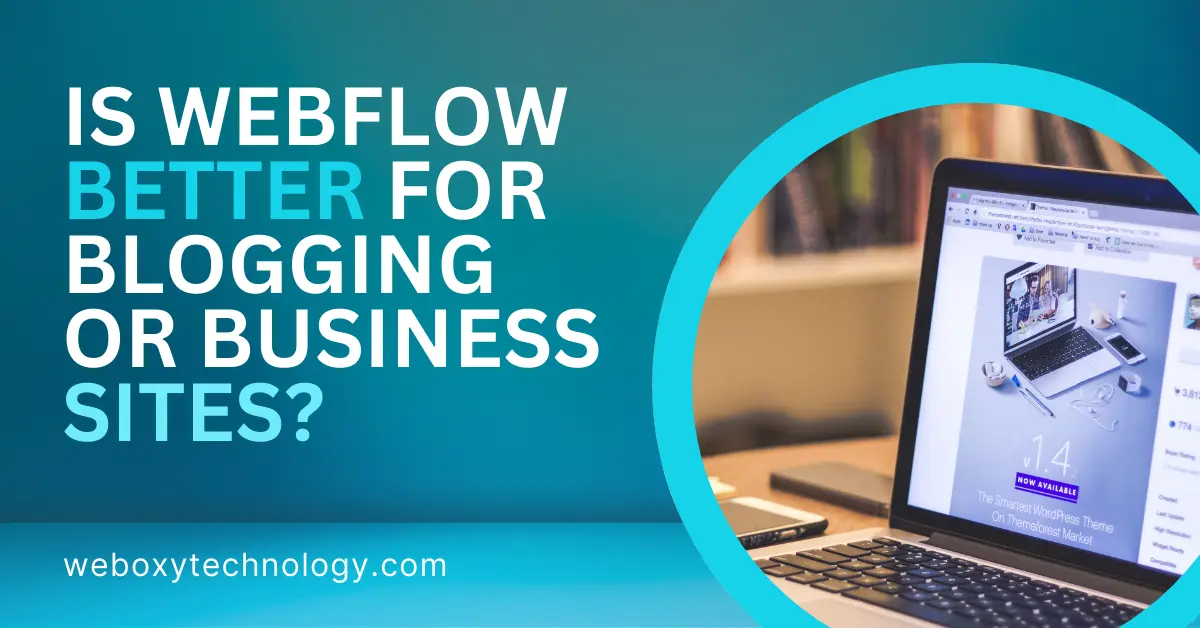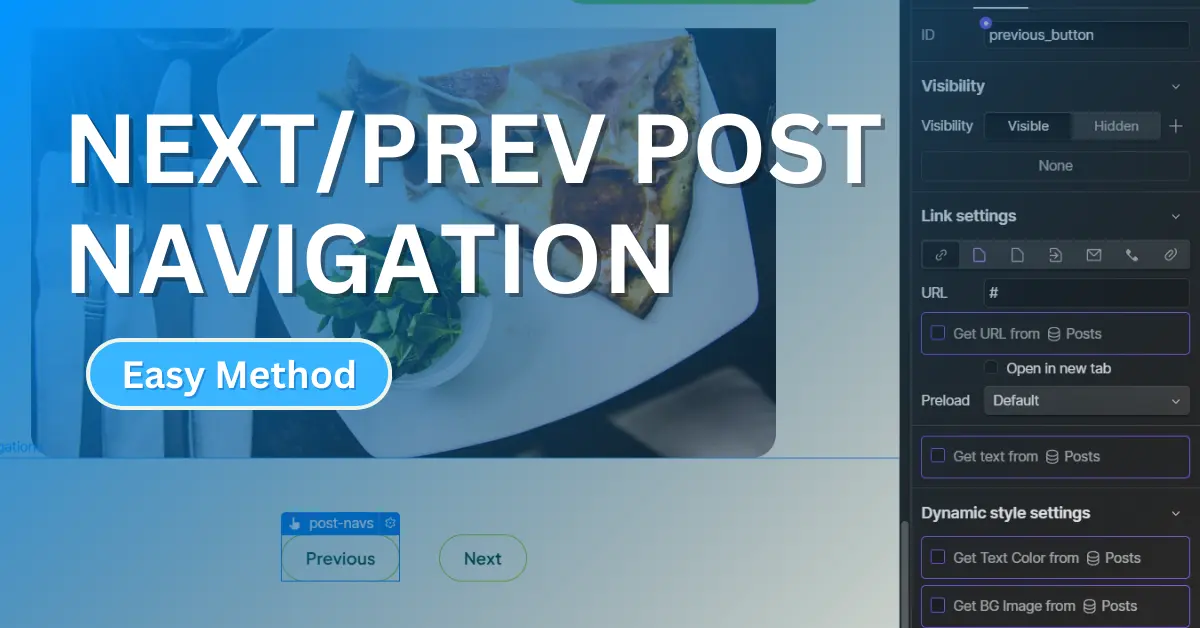Introduction
Webflow is a powerful web design tool that allows users to create visually stunning and highly functional websites without writing code. Its versatility makes it a go-to platform for bloggers and businesses alike. But how do the two compare in terms of what Webflow can offer?
In this blog, we’ll explore the key differences, benefits, and use cases of using Webflow for blogging sites versus business sites.
Webflow for Blogging Sites

Webflow’s user-friendly CMS (Content Management System) is perfect for bloggers looking to manage and publish content effortlessly. Let’s dive into the core features that make Webflow a fantastic choice for bloggers:
1. Customizable Blog Layouts and Templates
Webflow offers pre-designed templates that are easy to customize, allowing bloggers to focus on creating unique, visually appealing blogs. Whether you want a minimalist look or a feature-packed blog, Webflow gives you full control over the design.
2. CMS for Easy Content Management
The Webflow CMS is built to handle dynamic content, making it easy for bloggers to manage posts, categories, tags, and even schedule future posts.
It’s particularly beneficial for those who want to publish regular content without dealing with the technical complexities.
3. SEO Optimization Tools for Bloggers
Webflow comes with built-in SEO tools, making it easier to rank on search engines. You can easily manage meta titles, descriptions, alt text, and more. For bloggers, this is crucial for driving organic traffic to their site.
4. Blogging-Specific Features and Integrations
Webflow supports third-party integrations like Disqus for comments, social media share buttons, and email marketing tools, which are essential for engaging with your audience. These tools help build a community around your blog and increase interaction.
Webflow for Business Sites

Businesses have different priorities than bloggers, and Webflow is equipped with several advanced features to help companies grow and establish an online presence. Here’s what makes Webflow an ideal platform for business websites:
1. Business-Oriented Design Templates
Webflow offers a wide variety of professional templates geared towards businesses. These designs are optimized for lead generation, service showcasing, and building trust with your audience.
2. E-Commerce Capabilities
For businesses that want to sell products or services online, Webflow offers an intuitive e-commerce solution. You can customize your store’s appearance, set up payment gateways, and track orders—all within the platform.
3. Advanced Interactions and Animations
Businesses generally aim to deliver a memorable user experience.. Webflow’s advanced animations and interactions allow you to create engaging, interactive designs that captivate visitors and encourage them to explore your site further.
4. Integrations for Customer Management, CRM, and Marketing
Webflow’s seamless integrations with tools like Mailchimp, HubSpot, and Salesforce help businesses manage customer relationships, lead capture, and email marketing campaigns directly from their website.
Comparison: Blogging vs Business Sites
Now that we’ve explored what Webflow offers for both bloggers and businesses, let’s break down the key differences:
1. Content Structure and Focus
- Blogging: The primary focus is on delivering content in the form of blog posts, with a need for categories, tags, and archives.
- Business: Business sites focus on showcasing services, products, and case studies. They often require contact forms, lead capture, and service-related content.
2. Design Flexibility and Needs
- Blogging: While design is important, the emphasis is on readability and content delivery.
- Business: Businesses focus heavily on user experience, with a need for high-end visuals, interactive elements, and conversion-optimized design.
3. SEO Requirements and Approaches
- Blogging: SEO is largely content-driven, requiring optimized posts, meta tags, and fast-loading pages.
- Business: SEO for business sites focuses on local search optimization, lead generation, and competitive keyword targeting.
4. User Experience and Conversion Goals
- Blogging: The goal is to engage readers and encourage them to regular subscribers.
- Business: For businesses, the main goal is to convert visitors into customers or leads.
When to Choose Webflow for Blogging
If you’re a blogger looking for a flexible, scalable, and SEO-friendly platform, Webflow might be the perfect choice. Here are some scenarios where Webflow excels:
- You want full control over the design of your blog.
- You plan to publish content regularly and need a user-friendly CMS.
- SEO and organic traffic are important for your growth.
Pros:
Cons:
Example: Many creative bloggers use Webflow to showcase their work and build a personal brand, leveraging its powerful design tools.
When to Choose Webflow for Business Sites
For businesses, Webflow offers the perfect combination of design freedom, functionality, and professional tools. It’s ideal for companies looking to create a strong online presence that helps drive leads and sales.
Pros:
Cons:
Example: Many small and medium-sized businesses use Webflow for their professional websites, as it offers a sleek and modern design with all the necessary integrations.
Is Webflow Best for Blogging or Business Sites? – Final Thoughts
When it comes to choosing Webflow for blogging versus business sites, it’s all about your specific needs. For bloggers, Webflow provides full design control, SEO optimization, and easy content management. For businesses, it offers powerful features like e-commerce, professional templates, and advanced animations.
Whether you’re a content creator or a business owner, Webflow’s versatility ensures that you can create a site tailored to your goals. However, it’s important to note that Webflow is payable, not free, and can be challenging for those seeking short-term or no-money blogging ventures.
Decide based on your priorities—whether it’s content creation or business growth—and Webflow can help you achieve success online.
Ready to transform your online presence with Creative Websites? Contact Weboxy Technology, a leading Webflow and web development agency, for stunning, high-performing websites that captivate your audience!



